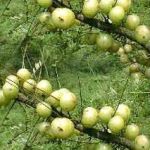| Common Name: |
Amla |
| Other Names: |
Emblic Myrobalan, Amalaki, Aonla |
| Botanical Name: |
Phyllanthus emblica syn. Emblica offinalis |
| Genus: |
Phyllanthus |
| Family: |
Euphorbiaceae |
| Native Location: |
Tropical Asia |
| Cultivation: |
Well-drained soil in sun with high humidity. |
| Propagation: |
By seed sown when ripe. |
| Harvest: |
Whole plants are collected during summer and autumn and used fresh or dried in decoctions, or pounded with roots as a poultice. Fruits are collected when unripe or ripe for decoctions, powder, and candy. Roots and bark are collected as required for decoctions. |
| Height: |
10-15m (30-45ft) |
| Width: |
5-8m (15-25ft) |
| Hardiness: |
Min. 15°C (59°F) |
| Parts Used: |
Fruits, leaves, bark, roots |
| Properties: |
A cooling, astringent, tonic herb that controls bleeding, improves digestion, and has laxative effects. It is considered rejuvenative and aphrodisiac. |
| Medicinal Uses: |
Internally for debility, anemia, poor appetite, fever, diabetes, nausea and vomiting, constipation, gastritis, colitis, hepatitis, jaundice, hemorrhage, hemorrhoids, and diarrhea. Externally for sores, eye infections, and pruritis. |
| Culinary Uses: |
Acid fruits are eaten raw or used in pickles, chutneys, sweetmeats, and preserves; also as a sour flavoring, like lemon juice, and dried as fruit chips which are eaten as snacks after fasting. |
| Economic Uses: |
Extracts are a common ingredient in Ayurvedic tonics. |
| Bibliography: |
Encylopedia of Herbs by Deni Brown Copyright ©: 1995, 2001 Dorling Kindersley Limited pps. 312-313
|

